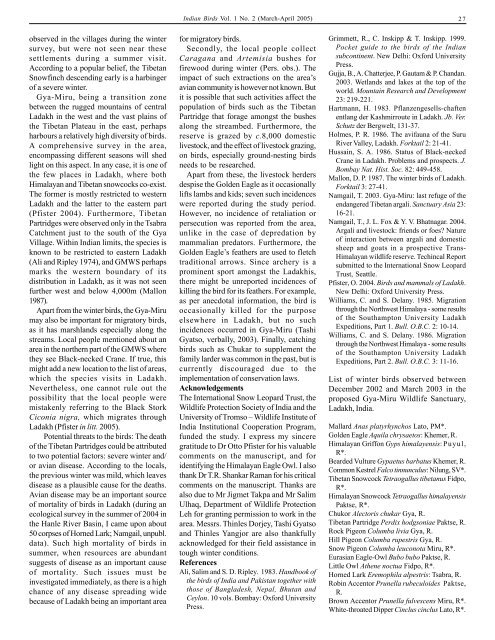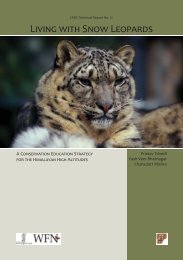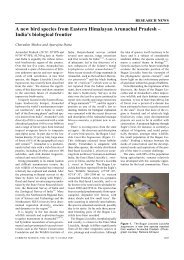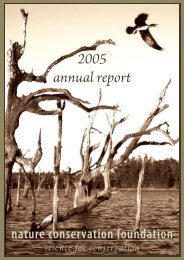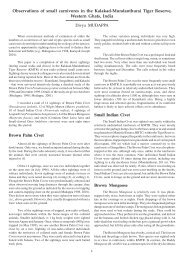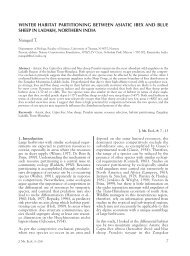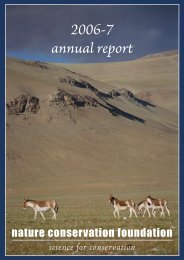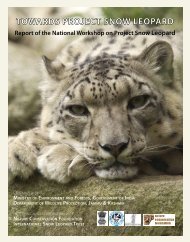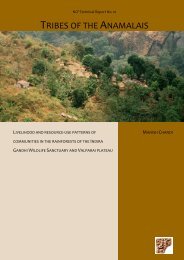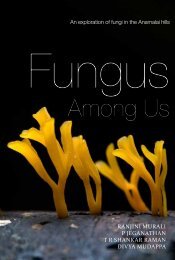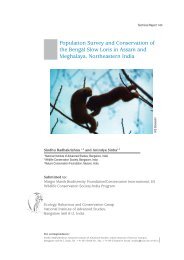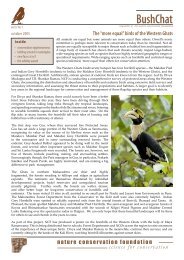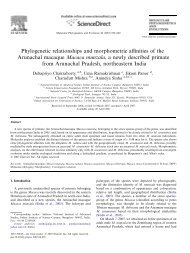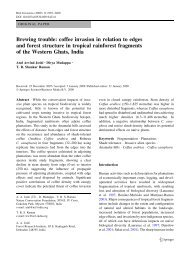Winter birds of the Gya-Miru Wildlife Sanctuary, Ladakh, Jammu and ...
Winter birds of the Gya-Miru Wildlife Sanctuary, Ladakh, Jammu and ...
Winter birds of the Gya-Miru Wildlife Sanctuary, Ladakh, Jammu and ...
Create successful ePaper yourself
Turn your PDF publications into a flip-book with our unique Google optimized e-Paper software.
observed in <strong>the</strong> villages during <strong>the</strong> winter<br />
survey, but were not seen near <strong>the</strong>se<br />
settlements during a summer visit.<br />
According to a popular belief, <strong>the</strong> Tibetan<br />
Snowfinch descending early is a harbinger<br />
<strong>of</strong> a severe winter.<br />
<strong>Gya</strong>-<strong>Miru</strong>, being a transition zone<br />
between <strong>the</strong> rugged mountains <strong>of</strong> central<br />
<strong>Ladakh</strong> in <strong>the</strong> west <strong>and</strong> <strong>the</strong> vast plains <strong>of</strong><br />
<strong>the</strong> Tibetan Plateau in <strong>the</strong> east, perhaps<br />
harbours a relatively high diversity <strong>of</strong> <strong>birds</strong>.<br />
A comprehensive survey in <strong>the</strong> area,<br />
encompassing different seasons will shed<br />
light on this aspect. In any case, it is one <strong>of</strong><br />
<strong>the</strong> few places in <strong>Ladakh</strong>, where both<br />
Himalayan <strong>and</strong> Tibetan snowcocks co-exist.<br />
The former is mostly restricted to western<br />
<strong>Ladakh</strong> <strong>and</strong> <strong>the</strong> latter to <strong>the</strong> eastern part<br />
(Pfister 2004). Fur<strong>the</strong>rmore, Tibetan<br />
Partridges were observed only in <strong>the</strong> Tsabra<br />
Catchment just to <strong>the</strong> south <strong>of</strong> <strong>the</strong> <strong>Gya</strong><br />
Village. Within Indian limits, <strong>the</strong> species is<br />
known to be restricted to eastern <strong>Ladakh</strong><br />
(Ali <strong>and</strong> Ripley 1974), <strong>and</strong> GMWS perhaps<br />
marks <strong>the</strong> western boundary <strong>of</strong> its<br />
distribution in <strong>Ladakh</strong>, as it was not seen<br />
fur<strong>the</strong>r west <strong>and</strong> below 4,000m (Mallon<br />
1987).<br />
Apart from <strong>the</strong> winter <strong>birds</strong>, <strong>the</strong> <strong>Gya</strong>-<strong>Miru</strong><br />
may also be important for migratory <strong>birds</strong>,<br />
as it has marshl<strong>and</strong>s especially along <strong>the</strong><br />
streams. Local people mentioned about an<br />
area in <strong>the</strong> nor<strong>the</strong>rn part <strong>of</strong> <strong>the</strong> GMWS where<br />
<strong>the</strong>y see Black-necked Crane. If true, this<br />
might add a new location to <strong>the</strong> list <strong>of</strong> areas,<br />
which <strong>the</strong> species visits in <strong>Ladakh</strong>.<br />
Never<strong>the</strong>less, one cannot rule out <strong>the</strong><br />
possibility that <strong>the</strong> local people were<br />
mistakenly referring to <strong>the</strong> Black Stork<br />
Ciconia nigra, which migrates through<br />
<strong>Ladakh</strong> (Pfister in litt. 2005).<br />
Potential threats to <strong>the</strong> <strong>birds</strong>: The death<br />
<strong>of</strong> <strong>the</strong> Tibetan Partridges could be attributed<br />
to two potential factors: severe winter <strong>and</strong>/<br />
or avian disease. According to <strong>the</strong> locals,<br />
<strong>the</strong> previous winter was mild, which leaves<br />
disease as a plausible cause for <strong>the</strong> deaths.<br />
Avian disease may be an important source<br />
<strong>of</strong> mortality <strong>of</strong> <strong>birds</strong> in <strong>Ladakh</strong> (during an<br />
ecological survey in <strong>the</strong> summer <strong>of</strong> 2004 in<br />
<strong>the</strong> Hanle River Basin, I came upon about<br />
50 corpses <strong>of</strong> Horned Lark; Namgail, unpubl.<br />
data). Such high mortality <strong>of</strong> <strong>birds</strong> in<br />
summer, when resources are abundant<br />
suggests <strong>of</strong> disease as an important cause<br />
<strong>of</strong> mortality. Such issues must be<br />
investigated immediately, as <strong>the</strong>re is a high<br />
chance <strong>of</strong> any disease spreading wide<br />
because <strong>of</strong> <strong>Ladakh</strong> being an important area<br />
Indian Birds Vol. 1 No. 2 (March-April 2005)<br />
for migratory <strong>birds</strong>.<br />
Secondly, <strong>the</strong> local people collect<br />
Caragana <strong>and</strong> Artemisia bushes for<br />
firewood during winter (Pers. obs.). The<br />
impact <strong>of</strong> such extractions on <strong>the</strong> area’s<br />
avian community is however not known. But<br />
it is possible that such activities affect <strong>the</strong><br />
population <strong>of</strong> <strong>birds</strong> such as <strong>the</strong> Tibetan<br />
Partridge that forage amongst <strong>the</strong> bushes<br />
along <strong>the</strong> streambed. Fur<strong>the</strong>rmore, <strong>the</strong><br />
reserve is grazed by c.8,000 domestic<br />
livestock, <strong>and</strong> <strong>the</strong> effect <strong>of</strong> livestock grazing,<br />
on <strong>birds</strong>, especially ground-nesting <strong>birds</strong><br />
needs to be researched.<br />
Apart from <strong>the</strong>se, <strong>the</strong> livestock herders<br />
despise <strong>the</strong> Golden Eagle as it occasionally<br />
lifts lambs <strong>and</strong> kids; seven such incidences<br />
were reported during <strong>the</strong> study period.<br />
However, no incidence <strong>of</strong> retaliation or<br />
persecution was reported from <strong>the</strong> area,<br />
unlike in <strong>the</strong> case <strong>of</strong> depredation by<br />
mammalian predators. Fur<strong>the</strong>rmore, <strong>the</strong><br />
Golden Eagle’s fea<strong>the</strong>rs are used to fletch<br />
traditional arrows. Since archery is a<br />
prominent sport amongst <strong>the</strong> <strong>Ladakh</strong>is,<br />
<strong>the</strong>re might be unreported incidences <strong>of</strong><br />
killing <strong>the</strong> bird for its fea<strong>the</strong>rs. For example,<br />
as per anecdotal information, <strong>the</strong> bird is<br />
occasionally killed for <strong>the</strong> purpose<br />
elsewhere in <strong>Ladakh</strong>, but no such<br />
incidences occurred in <strong>Gya</strong>-<strong>Miru</strong> (Tashi<br />
<strong>Gya</strong>tso, verbally, 2003). Finally, catching<br />
<strong>birds</strong> such as Chukar to supplement <strong>the</strong><br />
family larder was common in <strong>the</strong> past, but is<br />
currently discouraged due to <strong>the</strong><br />
implementation <strong>of</strong> conservation laws.<br />
Acknowledgements<br />
The International Snow Leopard Trust, <strong>the</strong><br />
<strong>Wildlife</strong> Protection Society <strong>of</strong> India <strong>and</strong> <strong>the</strong><br />
University <strong>of</strong> Tromso – <strong>Wildlife</strong> Institute <strong>of</strong><br />
India Institutional Cooperation Program,<br />
funded <strong>the</strong> study. I express my sincere<br />
gratitude to Dr Otto Pfister for his valuable<br />
comments on <strong>the</strong> manuscript, <strong>and</strong> for<br />
identifying <strong>the</strong> Himalayan Eagle Owl. I also<br />
thank Dr T.R. Shankar Raman for his critical<br />
comments on <strong>the</strong> manuscript. Thanks are<br />
also due to Mr Jigmet Takpa <strong>and</strong> Mr Salim<br />
Ulhaq, Department <strong>of</strong> <strong>Wildlife</strong> Protection<br />
Leh for granting permission to work in <strong>the</strong><br />
area. Messrs. Thinles Dorjey, Tashi <strong>Gya</strong>tso<br />
<strong>and</strong> Thinles Yangjor are also thankfully<br />
acknowledged for <strong>the</strong>ir field assistance in<br />
tough winter conditions.<br />
References<br />
Ali, Salim <strong>and</strong> S. D. Ripley. 1983. H<strong>and</strong>book <strong>of</strong><br />
<strong>the</strong> <strong>birds</strong> <strong>of</strong> India <strong>and</strong> Pakistan toge<strong>the</strong>r with<br />
those <strong>of</strong> Bangladesh, Nepal, Bhutan <strong>and</strong><br />
Ceylon. 10 vols. Bombay: Oxford University<br />
Press.<br />
27<br />
Grimmett, R., C. Inskipp & T. Inskipp. 1999.<br />
Pocket guide to <strong>the</strong> <strong>birds</strong> <strong>of</strong> <strong>the</strong> Indian<br />
subcontinent. New Delhi: Oxford University<br />
Press.<br />
Gujja, B., A. Chatterjee, P. Gautam & P. Ch<strong>and</strong>an.<br />
2003. Wetl<strong>and</strong>s <strong>and</strong> lakes at <strong>the</strong> top <strong>of</strong> <strong>the</strong><br />
world. Mountain Research <strong>and</strong> Development<br />
23: 219-221.<br />
Hartmann, H. 1983. Pflanzengesells-chaften<br />
entlang der Kashmirroute in <strong>Ladakh</strong>. Jb. Ver.<br />
Schutz der Bergwelt, 131-37.<br />
Holmes, P. R. 1986. The avifauna <strong>of</strong> <strong>the</strong> Suru<br />
River Valley, <strong>Ladakh</strong>. Forktail 2: 21-41.<br />
Hussain, S. A. 1986. Status <strong>of</strong> Black-necked<br />
Crane in <strong>Ladakh</strong>. Problems <strong>and</strong> prospects. J.<br />
Bombay Nat. Hist. Soc. 82: 449-458.<br />
Mallon, D. P. 1987. The winter <strong>birds</strong> <strong>of</strong> <strong>Ladakh</strong>.<br />
Forktail 3: 27-41.<br />
Namgail, T. 2003. <strong>Gya</strong>-<strong>Miru</strong>: last refuge <strong>of</strong> <strong>the</strong><br />
endangered Tibetan argali. <strong>Sanctuary</strong> Asia 23:<br />
16-21.<br />
Namgail, T., J. L. Fox & Y. V. Bhatnagar. 2004.<br />
Argali <strong>and</strong> livestock: friends or foes? Nature<br />
<strong>of</strong> interaction between argali <strong>and</strong> domestic<br />
sheep <strong>and</strong> goats in a prospective Trans-<br />
Himalayan wildlife reserve. Techincal Report<br />
submitted to <strong>the</strong> International Snow Leopard<br />
Trust, Seattle.<br />
Pfister, O. 2004. Birds <strong>and</strong> mammals <strong>of</strong> <strong>Ladakh</strong>.<br />
New Delhi: Oxford University Press.<br />
Williams, C. <strong>and</strong> S. Delany. 1985. Migration<br />
through <strong>the</strong> Northwest Himalaya - some results<br />
<strong>of</strong> <strong>the</strong> Southampton University <strong>Ladakh</strong><br />
Expeditions, Part 1. Bull. O.B.C. 2: 10-14.<br />
Williams, C. <strong>and</strong> S. Delany. 1986. Migration<br />
through <strong>the</strong> Northwest Himalaya - some results<br />
<strong>of</strong> <strong>the</strong> Southampton University <strong>Ladakh</strong><br />
Expeditions, Part 2. Bull. O.B.C. 3: 11-16.<br />
List <strong>of</strong> winter <strong>birds</strong> observed between<br />
December 2002 <strong>and</strong> March 2003 in <strong>the</strong><br />
proposed <strong>Gya</strong>-<strong>Miru</strong> <strong>Wildlife</strong> <strong>Sanctuary</strong>,<br />
<strong>Ladakh</strong>, India.<br />
Mallard Anas platyrhynchos Lato, PM*.<br />
Golden Eagle Aquila chrysaetos: Khemer, R.<br />
Himalayan Griffon Gyps himalayensis:Puyul,<br />
R*.<br />
Bearded Vulture Gypaetus barbatus Khemer, R.<br />
Common Kestrel Falco tinnunculus: Nilung, SV*.<br />
Tibetan Snowcock Tetraogallus tibetanus Fidpo,<br />
R*.<br />
Himalayan Snowcock Tetraogallus himalayensis<br />
Paktse, R*.<br />
Chukor Alectoris chukar <strong>Gya</strong>, R.<br />
Tibetan Partridge Perdix hodgsoniae Paktse, R.<br />
Rock Pigeon Columba livia <strong>Gya</strong>, R.<br />
Hill Pigeon Columba rupestris <strong>Gya</strong>, R.<br />
Snow Pigeon Columba leuconota <strong>Miru</strong>, R*.<br />
Eurasian Eagle-Owl Bubo bubo Paktse, R.<br />
Little Owl A<strong>the</strong>ne noctua Fidpo, R*.<br />
Horned Lark Eremophila alpestris: Tsabra, R.<br />
Robin Accentor Prunella rubeculoides Paktse,<br />
R.<br />
Brown Accentor Prunella fulvescens <strong>Miru</strong>, R*.<br />
White-throated Dipper Cinclus cinclus Lato, R*.


